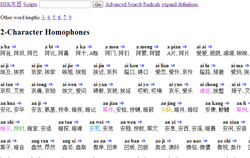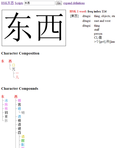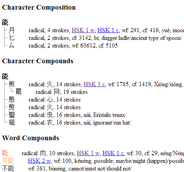 I'm not sure if there's much point to this one, but just in case someone ever needs it- here's a page that lists all Chinese homophones, with a page for each word length: http://hskhsk.pythonanywhere.com/homophonesI am defining homophones as words with identical pinyin. You can choose whether or not tones should be ignored by selecting the appropriate option.
I have seen this question asked a few times, so here's the best answer I am able to give. - I have collected together and added English for some example sentences that demonstrate grammatical points for the HSK 1, HSK 2, and HSK 3. These example sentences can also be downloaded as flashcard files for use in software such as Pleco and StickyStudy.
- The excellent AllSet Learning Grammar Wiki has a page that classifies the grammatical points on the site into 6 levels. These seem to correspond roughly to the six HSK levels, so it would be a good idea to ensure you are familiar with the grammatical points in the appropriate levels.
- Another post on this site shows the contents page of the great grammar book Common Chinese Patterns 330 by Qin Xue Herzberg. I have classified the patterns by HSK level, and there are popup tooltips with information about the characters. The best way to use this list is to study the appropriate patterns from the book.
- The sample exams at the official HSK site chinesetest.cn has quite a few sample exams for each level; doing all of the exams is great practice at seeing the different ways grammatical points can occur.
- Some other grammar books that I own that are useful but don't have any information on the HSK level of each point specifically are: Basic Patterns of Chinese Grammar by Chen Ru, Modern Mandarin Chinese Grammar by Claudia Ross, Schaum's Outline of Chinese Grammar by Claudia Ross.
- These sites don't have much information on their suitability for HSK levels, but are a great resources: Chinese Grammar by Hugh Grigg (who also has an awesome blog), Oxford University's grammar notes, and these basic review slides at Rutgers are a great way to start.
- The HSK grammar books I have found tend to be focused on the 'Old' HSK, and so they might not match the New HSK too well. I have listed a few in case you are willing to try them (I haven't) Practising HSK Grammar by Zhang Jing, Essentials of HSK Grammar by Zhao Jing, HSK Grammar by Fu Yuping, Brushing Up Your Grammar for HSK by Dong Cui, HSK Grammar Guidebook by Han Zhigang
- I would love to find some more good books and resources for studying Chinese grammar- let me know if you have any suggestions
 My HSK list browsing script took a step closer to being a real dictionary. I added: - Pinyin (tones optional) search, no wildcards yet
- English (definition) search
- All of the searches are done from the same edit field, very few things will match both English and pinyin, if they do you'll get
- Greying out of words/chars that only have frequency information and no dictionary entries
- Added pinyin and definitions to the tooltip text for all characters/words.
- Colouring of links to HSK list pages
And it's still lighting fast, and as before shows CC-CEDICT definitions, character composition, and word compounds. Give it a try 现在! http://hskhsk.pythonanywhere.com/cidian?q=%E7%8E%B0%E5%9C%A8
A few people have asked me this by email, so here's the answer I gave them: Remember, to really 'know' an HSK word you have to be able to use it in all of the different ways that Hanban expects you to. See my recent posts on HSK 1, HSK 2, and HSK 3 example sentences.
These HSK 3 example sentences demonstrate the different ways that some HSK 1 words can be used. See my other posts for HSK 1 and HSK 2 example sentences.The first 70 hanzi sentences (to which I added pinyin and English) were taken from the HSK information published by Hanban on www.chinesetest.cn . The rest were created by me to demonstrate the way that specific words (highlighted with 『』square brackets) are used. They are also available as a flashcard text file for HSK levels 1-3. Please share any more examples that you have in the comments. 94 sentences are with hanzi, pinyin, and English are shown after the jump!
These HSK 2 example sentences demonstrate the different ways that some HSK 2 words can be used. See my other posts for HSK 1 and HSK 3 examples. They are taken from the HSK information published by Hanban on www.chinesetest.cn . They are also available as a flashcard text file for HSK levels 1-3. Please share any more examples that you have in the comments. 53 sentences are with hanzi, pinyin, and English are shown after the jump!
These HSK 1 example sentences demonstrate the different ways that some HSK 1 words can be used. See my other posts for HSK 2 and HSK 3 examples. They are taken from the HSK information published by Hanban on www.chinesetest.cn . They are also available as a flashcard text file for HSK levels 1-3. Please share any more examples that you have in the comments. 48 sentences are with hanzi, pinyin, and English are shown after the jump!
As well as learning the vocabulary for each HSK level, you have to learn how to use the words in a sentence. For some words such as nouns this is pretty obvious, but some verbs and other harder to classify words can only really be learned by example. I have created files which give example sentences for HSK levels 1-3, but even if you aren't studying for the HSK they might be useful for you. You can either browse these files to verify that you understand the usage examples or import them into a flashcard testing app. There are versions formatted for both Pleco and for Hanzi StickyStudy. The formats are simple tab-separated and it shouldn't be hard to modify them for other flashcard programs. I mentioned this file before, but I have added English translations for level 3, and started adding my own example sentences for a few of the level 3 words where the usage isn't completely obvious.
I'm a big fan of the AllSet Learning Grammar Wiki, and one of the most useful things I've come across on there is a few pages that list Chinese grammatical points according to their European Common Framework level. These six levels roughly correspond to the six levels of the New HSK, so it would be a good idea for someone studying for the HSK to ensure that they are familiar with all of the grammar points at their level and below. Each list of grammatical points links to a page with more explanations and examples, a really great resource! I have noted the corresponding HSK levels for each page.
|



 RSS Feed
RSS Feed